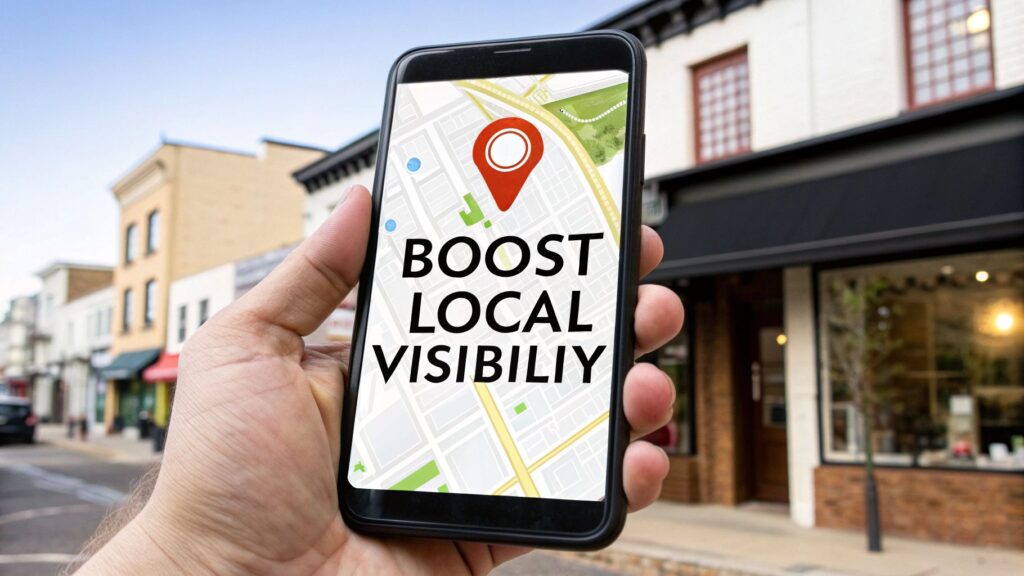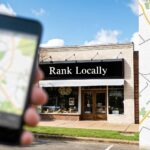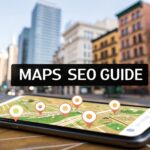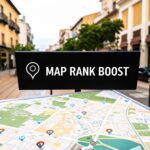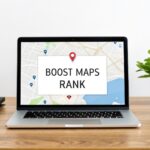When someone's car breaks down, they aren't browsing for options. They're stranded, stressed, and searching their phone for the nearest, fastest help. This is why mastering SEO for roadside assistance is critical—it puts your business at the top of their list when they need you most. A good strategy ensures that when a driver is in trouble, your company is the first one they find and call.
Why Local SEO Is a Lifeline for Your Business
Think about how you search for things. If you look up "coffee shop near me," you probably pick one of the first few results Google shows. Now imagine that same situation, but instead of coffee, a driver has a flat tire on a busy highway. The need is much more urgent.
This is the whole game for your roadside assistance company. Local SEO isn't about long-term branding. It's about being the immediate solution to a problem happening right now.
- Urgent Need: Customers are not shopping around. They are in a jam and will call the first reputable company they find.
- Mobile-First World: Nearly 100% of these searches happen on a smartphone. Your online presence must work perfectly on mobile devices.
- Hyper-Local Searches: People aren't just searching for "tow truck." They are searching for "tow truck I-95 exit 42" or "roadside assistance downtown."
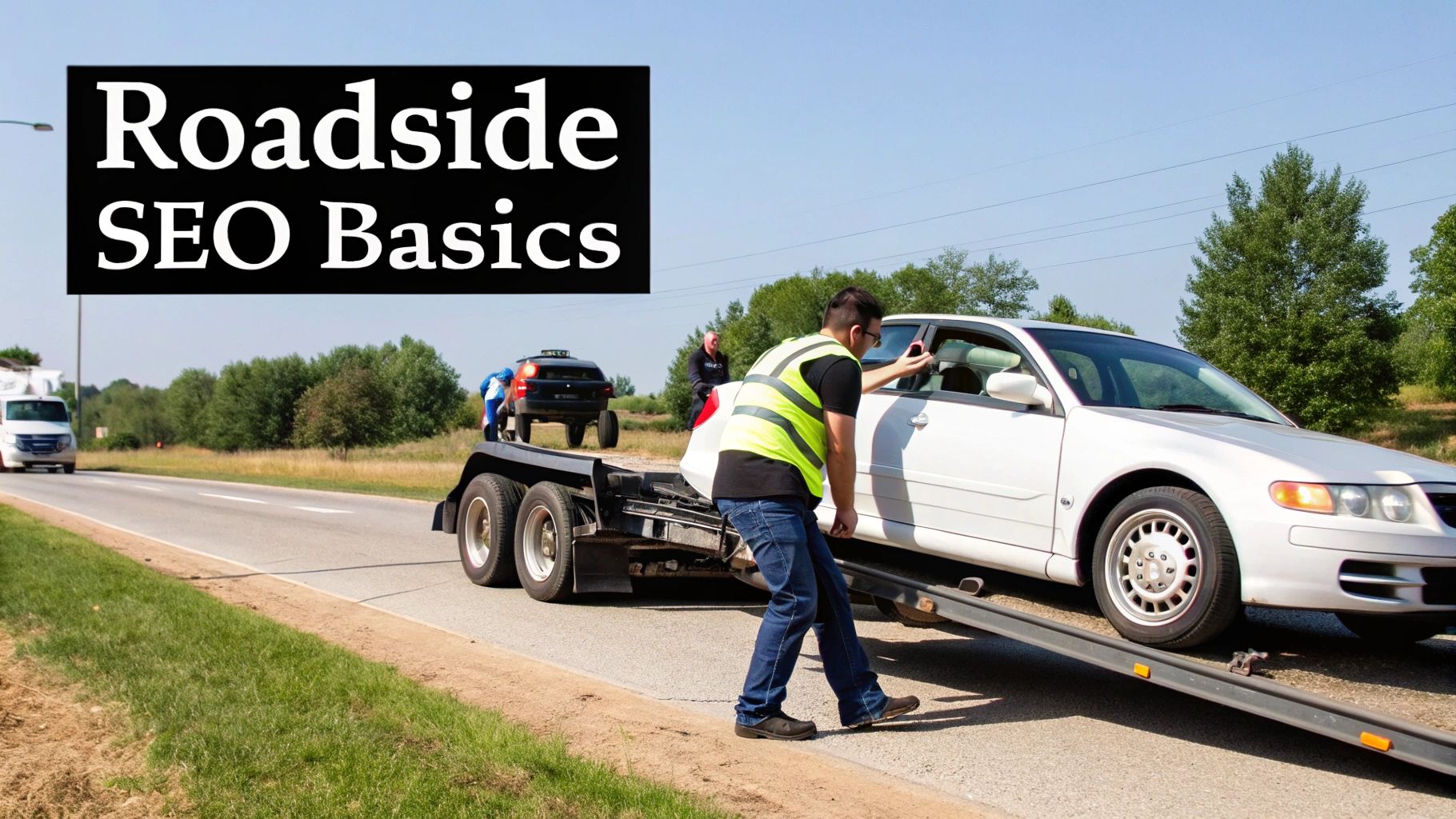
Connecting With Stranded Drivers Instantly
Old marketing methods like flyers or billboards don't work for emergencies. They can't match the speed of a Google search. When a driver is in distress, your online visibility acts as your storefront and salesperson. If you don't show up in the top local search results, you don't exist in their moment of need.
The market for roadside help is growing. The global vehicle roadside assistance market is projected to hit USD 44.1 billion by 2035. That's a huge jump from USD 28.7 billion in 2025. A solid online strategy is your ticket to getting a piece of that growth.
In Short: Your next customer is on the side of a highway with their phone, ready to call the first company that looks professional, nearby, and trustworthy.
Making sure your business is that first choice is what we'll cover. For a deeper look at the basics, these Local SEO strategies for small businesses are a great start. Now, let's get into the steps that will make your phone ring.
Turning Your Google Business Profile into a Call Magnet
Your Google Business Profile (GBP) is your most important online asset. When a driver is stuck, the Google Maps "snack pack" is their lifeline. If your profile isn't optimized, you're giving calls—and money—to your competition.
Think of your GBP as your emergency billboard. A stranded driver needs to know three things fast: who you are, what you do, and if they can trust you. An incomplete profile looks unreliable, and they'll just tap the next name on the list.
Key Takeaway: Your GBP is often the first and only impression you'll make on a customer in distress. A well-optimized profile builds instant trust and convinces them you're the right call.
Nail the Basics First: Your Business Categories
This seems simple, but it's the foundation of your GBP strategy. Your categories tell Google what you do so it can show you to the right people.
- Primary Category: This should almost always be "Towing Service." It's the most common term people search for in a panic.
- Secondary Categories: Get specific here. Add everything else you do, like "Roadside Assistance," "Tire Shop," and "Car Lockout Service." The more relevant categories you add, the more searches you'll appear in.
Making "Towing Service" your primary category casts the widest net for urgent calls. The others help you capture people who just need a jump-start or have locked their keys in the car.
Write a Description That Speaks to Drivers in Distress
Your business description isn't the place for corporate jargon. You have 750 characters to convince a stressed person you are their solution. Be direct, empathetic, and use the keywords they're thinking of.
Put yourself in their shoes. What do they need to know?
- How fast you can get there
- That you're available 24/7
- The exact areas you cover
- A quick list of your main services (flat tire, lockout, jump-start, towing)
Here’s an example that works:
"Stranded in the Dallas-Fort Worth area? We offer fast, 24/7 roadside assistance and towing. Whether you've got a flat tire, locked your keys in the car, or need an emergency tow, our crew is ready to roll. We handle jump-starts, fuel delivery, and lockouts across Dallas, Plano, and Arlington. Call now for immediate help!"
This is clear, mentions specific services and locations, and has an urgent, helpful tone. It answers the driver's questions before they ask.
This infographic shows a simple way to find the right keywords for your GBP.
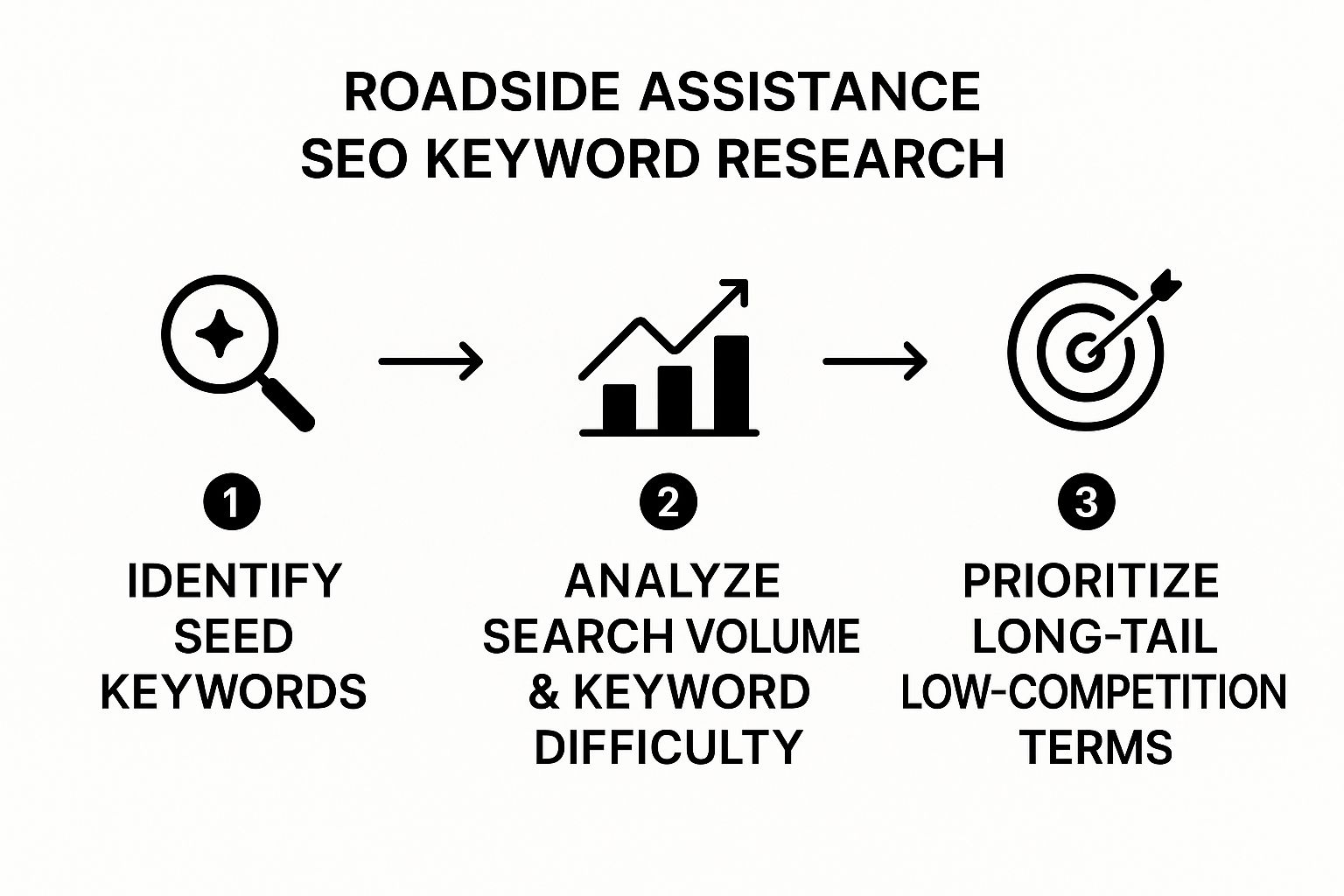
The key is to start broad and drill down to specific, high-urgency phrases that attract customers ready to call.
Here is a quick checklist to help you optimize your profile.
Google Business Profile Optimization Checklist
This table walks you through the must-have elements for a top-performing roadside assistance GBP.
| GBP Element | Optimization Action | Why It Matters for Roadside Assistance |
|---|---|---|
| Business Name | Use your exact, legal business name. No extra keywords. | Consistency builds trust. Google penalizes "keyword stuffing" in names. |
| Primary Category | Set to "Towing Service". | This is the most powerful signal to Google for capturing high-intent searches. |
| Secondary Categories | Add all relevant services (e.g., Roadside Assistance, Car Lockout Service). | Helps you rank for more specific, non-towing service searches. |
| Service Area | List all specific cities, towns, and zip codes you serve. | Tells Google (and customers) exactly where you operate so you show up in relevant "near me" searches. |
| Hours of Operation | Set to 24/7 if you offer it. Keep it accurate. | This is non-negotiable for an emergency service. Inaccurate hours kill trust instantly. |
| Phone Number | Use a local number with a local area code. It must be a direct line. | A local number feels more trustworthy than an 800 number. This is your main call-to-action. |
| Business Description | Write a customer-focused, 750-character description. Mention key services & locations. | Your chance to quickly convince a panicked driver you're the right choice. |
| Photos & Videos | Upload high-quality, real photos of your trucks, team, and logo. Add new ones regularly. | Shows you're a real, professional operation. A photo of a clean truck is reassuring. |
| Reviews | Actively request reviews from every customer. Respond to all of them (good and bad). | Social proof is critical. Lots of recent, positive reviews is the #1 trust signal. |
| Google Posts | Publish updates, offers, or tips at least once a week. | Keeps your profile active, which Google likes, and helps you stand out. |
| Q&A Section | Pre-populate with common questions (e.g., "What are your rates?"). | Answers customer questions proactively and lets you control the narrative. |
Going through this checklist is one of the highest-impact things you can do for your business. A fully optimized profile is a lead-generating machine.
How do I optimize my GMB for roadside assistance?
Focus on detail and consistency. First, make sure your NAP (Name, Address, Phone number) is identical everywhere online. Choose "Towing Service" as your primary GBP category, then add secondary ones like "Roadside Assistance." Upload high-quality photos of your trucks and team. Most importantly, ask for and respond to every customer review.
What is the most important part of a Google Business Profile?
For a roadside assistance business, it’s a tie between your reviews and your primary category. Reviews build instant trust with someone in a vulnerable situation. Your primary category ("Towing Service") is a clear signal to Google, telling it what you do so it can show your business to people who need that service right now.
How do I get more towing leads from Google Maps?
To get more calls from Google Maps, you have to appear in the "snack pack"—the top three local results. You do this with a perfectly optimized GBP, a steady stream of positive reviews, and consistent business info across the web. Pro tip: use Google Posts to share updates or offers. This increases engagement and makes your profile stand out in Maps.
Designing a Website That Converts Drivers in Distress
Imagine someone stuck on the highway at night in the rain. They pull out their phone to Google for help. Your website is the first one they click. You have about three seconds to convince them you're the right call.
This isn't a normal customer journey. It’s a crisis. Your website can't just be a pretty brochure; it needs to be an emergency tool for someone who is stressed and distracted.

Mobile-First Isn't a Suggestion, It's a Requirement
Let’s be clear: 100% of your emergency customers are on a smartphone. Your website must be built for their experience. That means more than just having a site that "shrinks to fit."
Think about their situation. They're likely using one hand, and they have zero patience for tiny text or hunting for a phone number.
A true mobile-first design assumes the user is on their phone. Every button, font, and image is optimized for a small screen and a quick, high-stakes interaction.
This way, the most important information is front and center. It makes it simple for a driver to get help immediately.
Speed Is Everything
In an emergency, a slow-loading website is a lost customer. If your page takes more than a few seconds to appear, that driver is hitting the "back" button and calling your competitor.
- Shrink Your Images: Large images are the main cause of slow sites. Use tools to reduce file sizes.
- Keep It Simple: A clean, straightforward design loads much faster.
- Invest in Good Hosting: Cheap hosting can slow down during peak traffic and cost you jobs.
A slow site will drive customers away. Learning how to improve website loading speed is essential for getting your phone to ring.
The Can't-Miss 'Tap-to-Call' Button
This might be the most important element on your site. When someone is stranded, they want to talk to a person—fast. Your phone number needs to be impossible to miss.
Make it a big, bright button that stays "sticky" at the top or bottom of the screen. Label it with something direct like "Tap to Call for Immediate Help." This simple feature removes all friction and turns a search into a phone call.
On-Page SEO That Dominates Local Searches
Your website’s structure needs to speak Google's language. This is how you show up when someone searches for a specific problem in a specific place. A single "services" page is not enough.
You need dedicated pages for every service and every location you cover.
- Service-Specific Pages: Have individual pages for "Flat Tire Repair," "Car Lockout Service," "Battery Jump-Start," and "Emergency Towing." This helps you rank for specific searches.
- Location-Specific Pages: If you serve multiple towns, each needs its own page. For example, "Roadside Assistance in Arlington" or "Towing Services in Plano." This is how you win "near me" searches.
This strategy tells Google that you're the local authority for these exact services. It’s a powerful way to get the most qualified traffic. The U.S. roadside assistance market is projected to grow from $2.40 billion in 2025 to $3.69 billion by 2034. This growth is driven by app-based services that rely on online visibility, making sharp SEO more critical than ever.
Building Trust with Local Citations and Reviews
When a driver is stranded, they're looking for someone they can trust. In roadside assistance SEO, trust is a real ranking factor you build through consistency and customer feedback.
Two of the biggest ways to build this trust are with local citations and customer reviews.
Think of it this way: every time your business's name, address, and phone number (NAP) appears correctly online, it's a vote of confidence. It tells Google you're a real, legitimate local business. But if that information is inconsistent, it creates confusion and hurts trust.
Mastering Local Citations for Rock-Solid Consistency
A local citation is any online mention of your business's Name, Address, and Phone number (NAP). You'll find them on sites like Yelp, Yellow Pages, and other directories. The most important rule here is NAP consistency.
Every single listing must be a perfect match to the information on your Google Business Profile.
- No tiny variations: Even "Street" vs. "St." can cause problems for search engines.
- Audit your current listings: Use a tool like BrightLocal or Semrush to find and fix any mistakes.
- Build out new citations: Once your core info is clean, get your business listed in other reputable local and auto-industry directories.
In Short: Consistent NAP information is a key trust signal for Google. It confirms your business is real and located where you say you are, which is critical for local search results.
Inconsistent info sends mixed signals and makes Google hesitant to recommend you.
The Real Game-Changer: Customer Reviews
If citations prove you are who you say you are, reviews prove you're good at what you do. For a stranded driver, a long list of recent, positive reviews is often the final push they need to call. It's no surprise that 78% of customers call a business within 24 hours of a local mobile search—and reviews are often the deciding factor.
Getting reviews doesn't have to be awkward. The best time to ask is right after you’ve helped someone.
A Simple Script That Works:
"Glad we could get you back on the road! Hey, if you have a second, would you mind leaving us a quick review on Google? It really helps other drivers find us when they're in a jam."
It’s easy, direct, and frames it as helping others, which makes customers more likely to do it.
Turning Negative Reviews into a Positive
Bad reviews happen. How you handle them separates the pros from the amateurs. A quick, thoughtful response to a bad review can actually build more trust than a perfect five-star record.
Here's a simple approach:
- Acknowledge and Apologize: Start by validating their feelings. "I'm really sorry to hear you had a frustrating experience."
- Don't Argue: Never get defensive or make excuses in a public comment.
- Take it Offline: Give them a way to resolve the problem privately. "Please give me a call directly at [your number] so I can personally look into this and make it right."
This strategy shows potential customers that you take responsibility, turning a public complaint into a public display of great customer service.
Creating Content That Answers Urgent Driver Questions
Your content needs to do more than just list your services. You should become the local expert a stranded driver finds when they are Googling for answers. This builds trust and positions you as an authority before they need to call.
Think from the driver's perspective. They aren't just typing "tow truck near me." They're also asking questions like, "what does it mean when my car makes a grinding noise?" or "is it safe to drive with the check engine light on?"
Answering those questions is your secret weapon.
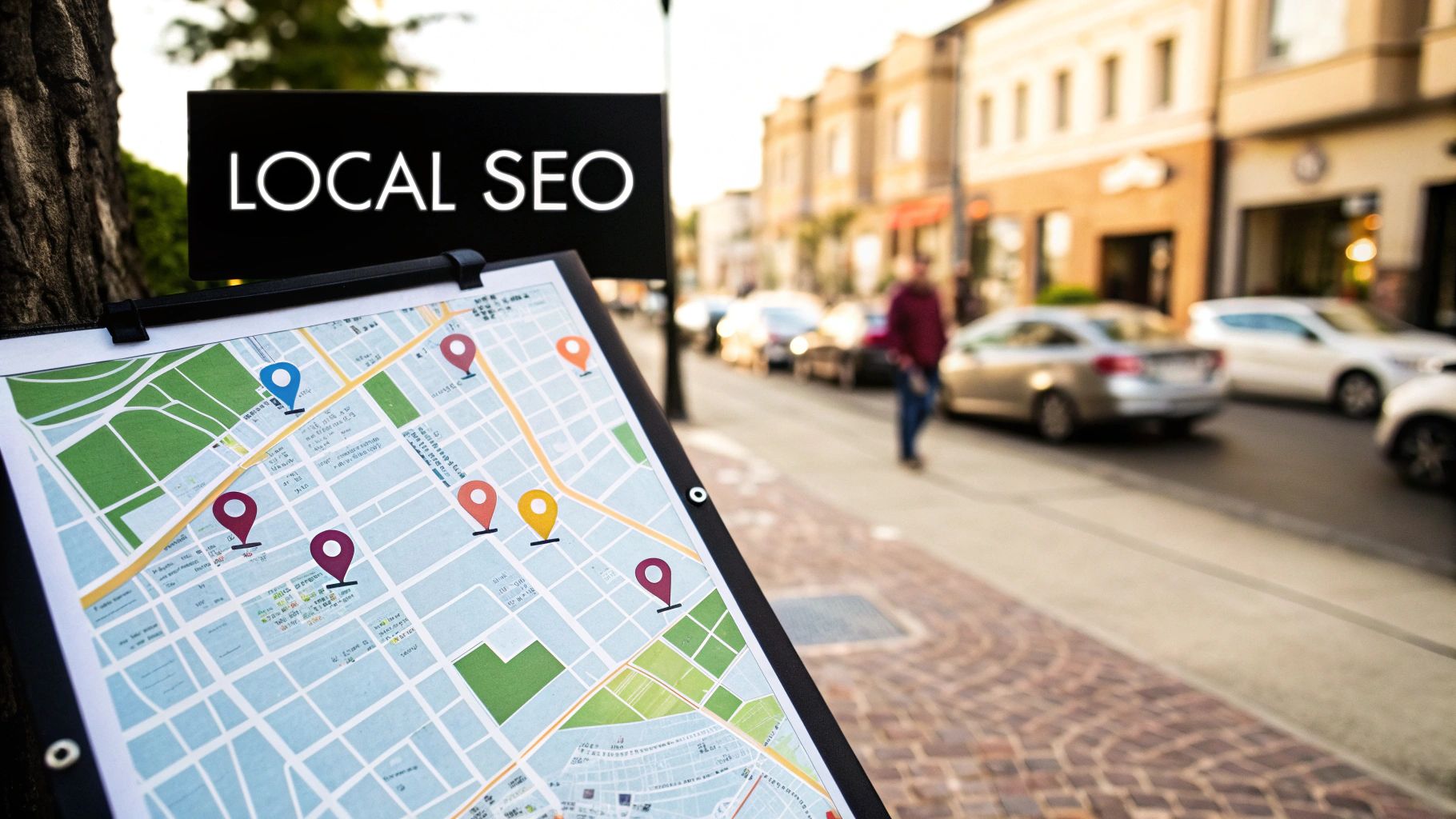
Write Helpful, Problem-Solving Blog Posts
Your blog is the perfect place to establish this expertise. Write about your customers' problems. When you become their go-to source for info, you'll be the first company they think of when they need help.
These types of posts work very well:
- "What to Do If Your Car Overheats on the Highway": A step-by-step guide for a high-stress situation.
- "5 Signs Your Car Battery Is About to Die": This content helps people before they're stranded, painting you as a proactive expert.
- "How to Safely Change a Tire on a Busy Road": Safety-focused content shows you care about your community's well-being.
This approach is used in other emergency services too. For example, the strategies in SEO for restoration companies also focus on creating content that answers urgent questions during a crisis.
Build Out Hyper-Local Location Pages
While blog posts attract people looking for information, location pages are for drivers who are ready to call now. You need a dedicated page for every city or town you cover.
Get specific on these pages. For example:
- Page Title: Roadside Assistance in Downtown Springfield
- Content: Don't just say you serve the area. Talk about it. Mention local landmarks or common breakdown spots. Reassure them you can get to that specific location fast.
In Short: Creating individual pages for each service area tells Google you're the most relevant choice for anyone searching from that specific spot.
This tactic is powerful for dominating the "near me" searches that are the lifeblood of any roadside assistance business.
What should I post on my towing company blog?
Keep it simple and direct. Answer the exact questions a driver would type into Google. Think about creating posts like "What Does It Mean When My Brakes Squeak?" or a checklist for "What to Keep in Your Car for a Roadside Emergency." Every article should provide real value and establish you as the local expert.
How do I get my towing company to show up on Google?
There isn't a single magic bullet. A solid strategy includes a few key things. Start with a perfectly optimized Google Business Profile. Then, build out dedicated service and location pages on your website. Finally, consistently create helpful blog content to build your site's authority over time.
How much does it cost to advertise a towing company?
The cost varies widely. A simple Google Ads campaign might start at a few hundred dollars per month, while comprehensive SEO (which is a longer-term investment) can range from $500 to over $5,000 per month depending on your market and goals. SEO builds lasting value, while ads provide immediate but temporary visibility.
Answering Your Top Roadside SEO Questions
Running a roadside assistance business is demanding. Figuring out SEO on top of that can be confusing. Here are some of the most common questions from owners like you, with straight answers.
How Long Does SEO Take to Work for a Roadside Company?
SEO is a marathon, not a sprint. You're building trust with Google, and that takes time.
For a new business, you might see some results for your company's name in about 3 to 6 months. To start showing up for valuable searches like "towing near me," you should plan for 6 to 12 months of consistent effort.
What affects the timeline?
- Local Competition: A crowded city takes longer than a small town.
- Website Quality: Is your site fast on a phone and easy to use?
- Review Velocity: How many new, positive reviews are you getting each week?
Consistency is key. A little work every week is more effective than a big push every six months.
Is a Blog Really Necessary for My Roadside Assistance Site?
It's not mandatory, but skipping it is a huge missed opportunity. A blog is your best tool for building topical authority.
When you publish a helpful article like, "5 Signs Your Car Battery is About to Die," you catch potential customers before they're stranded. You’re building brand recognition and trust.
This expertise helps your main service pages rank higher. When Google sees you as a helpful resource, it's more likely to trust you as a reliable provider for emergency services.
A blog helps you go from being "just another tow truck" to the go-to local authority on car care.
Should I Focus on My Website or Google Business Profile First?
Easy. For the fastest results, your Google Business Profile (GBP) is priority number one.
Your GBP is what appears in the Google Maps "3-pack," where most of your urgent calls will come from. Optimizing your GBP with the right categories and recent photos can generate calls almost immediately.
Your website is the long-term play. It's your home base for building your brand, ranking for more specific keywords, and housing helpful blog content.
Bottom line: Nail your Google Business Profile for quick wins. Then, continuously build out your website for long-term growth.
What Is the Single Most Important Factor for Local SEO?
The biggest ranking factor is one you can't control: proximity. Google almost always shows the searcher the business that is physically closest.
So, what's the most important factor you can control?
It’s a powerful one-two punch: a perfectly optimized Google Business Profile paired with a steady stream of positive customer reviews. This combination sends the strongest possible signal to Google that your business is legitimate, trustworthy, and the best solution for someone's problem right now.
When someone searches from your service area, that combo is what convinces Google to show you over a competitor who might be a little closer. It’s your tie-breaker.
Ready to stop worrying about SEO and start getting more calls? At Clicks Geek, we specialize in driving measurable growth for local service businesses. Let our team handle the digital marketing complexities so you can focus on what you do best—helping drivers get back on the road.
Discover how our targeted SEO services can make your phone ring
Is Your Business Ranking in Google Maps?
Turn Google Maps into a Lead Engine w/ Clicks Geek’s AI-powered local SEO. 3,000+ clients served. Our proprietary, fully done-for-you Maps SEO system handles everything—keyword targeting, local optimization, content, reviews, and ranking strategy—automatically.


